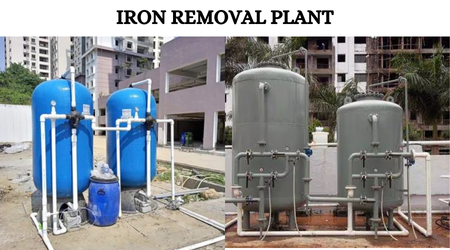
.png)
IRON REMOVAL PLANT
An iron removal plant is a facility designed to remove excess iron from water to make it safe for drinking, industrial, or agricultural use. High levels of iron in water can cause staining, taste issues, and can be harmful to health. The iron removal process typically involves several stages of filtration and chemical treatment to ensure the water meets quality standards.
Key Components and Processes of an Iron Removal Plant
1. Water Source
Groundwater or Surface Water: Iron-rich water is sourced from wells, rivers, lakes, or other water bodies.
2. Pre-Treatment
Aeration: Introduces air into the water to oxidize dissolved iron, converting it from a soluble ferrous (Fe²⁺) form to an insoluble ferric (Fe³⁺) form.
pH Adjustment: Adjusts the pH level of the water to enhance the oxidation and precipitation of iron.
3. Filtration
Sedimentation: Allows the oxidized iron particles to settle out of the water.
Sand Filtration: Uses a bed of sand to filter out the remaining iron particles.
Multimedia Filtration: Employs multiple layers of media (e.g., sand, anthracite, gravel) to remove suspended particles and precipitated iron.
4. Chemical Treatment
Chemical Oxidation: Uses oxidizing agents like chlorine, potassium permanganate, or ozone to oxidize iron if aeration is insufficient.
Coagulation and Flocculation: Adds coagulants to aggregate fine iron particles into larger flocs that can be easily filtered.
5. Advanced Filtration
Activated Carbon Filters: Removes any remaining organic matter and residual oxidizing agents.
Ion Exchange: Uses resins to remove iron and other dissolved minerals.
6. Post-Treatment
pH Stabilization: Adjusts the pH to a neutral level to prevent corrosion of pipes and plumbing.
Disinfection: Ensures the water is free from microorganisms using methods like UV sterilization or chlorination.
IRON REMOVAL PLANT - APPLICATIONS
1. Municipal Water Supply: Ensures safe drinking water for communities.
2. Industrial Use: Provides iron-free water for processes in industries such as textiles, food and beverage, pharmaceuticals, and electronics.
3. Agricultural Use: Supplies water for irrigation, preventing iron accumulation in soil and crops.
4. Household Use: Improves water quality for domestic use, preventing staining and plumbing issues.

.png)
.png)

.png)
.png)
.png)
.png)
.png)
.png)
.png)
.png)
.png)
.png)
.png)
.png)
.png)
.png)